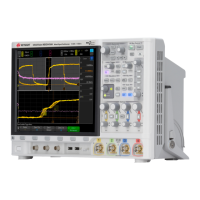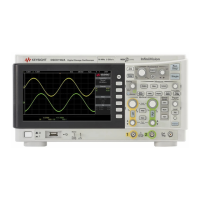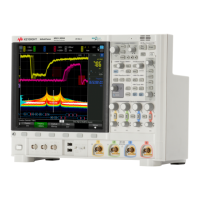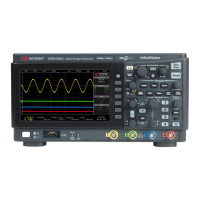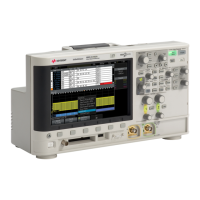
Do you have a question about the Keysight Technologies InfiniiVision 3000 X Series and is the answer not in the manual?
| Form Factor | Benchtop |
|---|---|
| Vertical Resolution | 8 bits |
| Timebase Range | 5 ns/div to 50 s/div |
| Operating Temperature | 0°C to 50°C |
| Channels | 2 or 4 |
| Memory Depth | up to 1 Mpts |
| Display | 8.5-inch |
| Waveform Update Rate | 1, 000, 000 waveforms/sec |
| FFT | Yes |
| Trigger Types | Edge, Pulse Width, Pattern |
| Input Impedance | 1 MΩ |
| Interface | USB, LAN, GPIB (optional) |
Information and warnings that must be followed by the user to ensure safe operation and maintain the product in a safe condition.
Instructions for checking the shipping container for damage and verifying received items and optional accessories.
Details on power requirements, ventilation, and the procedure to turn on the oscilloscope.
Procedure to match passive probe input characteristics to the oscilloscope channel for accurate measurements.
Instructions for adjusting the time/div setting using the horizontal scale knob.
Procedure for adjusting the horizontal delay (position) knob to move the trigger point.
Instructions for setting the vertical scale (volts/division) using the knob above the channel key.
Configuring probe parameters such as attenuation factor and units of measurement for connected probes.
Applying transform functions like differentiate, integrate, FFT, or square root to arithmetic operations.
Procedure for saving an analog channel or math waveform to one of two internal reference locations.
Instructions to display a saved reference waveform and compare it against other waveforms.
Steps for connecting digital probes to the device under test.
How the oscilloscope examines input voltage at each probe to trigger and display acquisitions.
Procedure to adjust the logic threshold for digital channels.
Procedure to adjust the trigger level for a selected analog channel using the Trigger Level knob.
Identifying a trigger by looking for a specified edge (slope) and voltage level on a waveform.
Identifying a trigger condition by looking for a specified pattern, a logical AND combination of channels.
Selecting between Auto and Normal trigger modes to define oscilloscope behavior when triggers are not occurring.
Selecting DC, AC, LF Reject, or TV coupling for the trigger path.
Using the front panel keys [Run/Stop] and [Single] to control the oscilloscope's acquisition system.
Choosing between Normal, Peak Detect, Averaging, or High Resolution acquisition modes.
Dividing memory into segments to capture multiple infrequent trigger events without capturing inactivity.
Procedure for placing and adjusting horizontal and vertical cursors for measurements.
Using the [Meas] key to make automatic measurements on waveforms.







